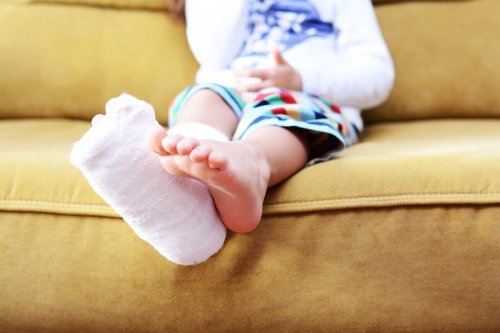Ankle Sprains in Children: What You Should Know

The more activity children do, the better they’ll develop and grow. Running, jumping, and playing are very important actions in their daily lives. However, all that energy may be the reason why ankle sprains in children are such common injuries.
What’s a sprain?
Sprains occur when a person falls violently or makes sudden movements, causing a ligament to stretch or tear. Although this condition can affect any body part, it mostly occurs in the ankles.
Ankle sprain symptoms in children
Sometimes, ankle sprains may cause mild symptoms that worsen as the days pass. However, the area immediately swells and there’s severe pain when walking. These are the most common symptoms of a sprain:
- Difficulty walking. Due to the severe pain and swelling in the affected joint.
- Inflammation. Although it doesn’t cause a deformity in the affected area as in the case of a fracture, it’s the most noticeable symptom.
- Bruising. Bruises aren’t very common but may occur due to a blood vessel rupture. If they do occur, it’ll be around the ankle; their color will change as the sprain goes away.
- Warm feeling. Due to the swelling and the concentration of blood in the area, there’s a warm sensation in the ankle.
“When children sprain their ankle, it’s important for them to try not to put weight on their foot and rest until the injury severity is determined.”
Types of sprains

Ankle sprains are divided into three degrees. Depending on the severity of the injury, the symptoms will be milder or more intense. These are the types of strains that can occur:
- Grade 1. A mild sprain; the ligaments stretched slightly. It causes mild pain and swelling.
- Grade 2. A moderate sprain. Incomplete ligament tear that causes pain, swelling, and difficulty putting weight on the ankle.
- Grade 3. Total ligament tear. It causes severe pain and swelling, as well as ankle instability and difficulty putting weight on it.
Causes of ankle sprains in children
Ankle sprains in children can occur for many different reasons. Most stem from walking on uneven floors, carrying toys, running with untied shoelaces, or a fall, among others.
In addition, this injury may be caused by a blow or someone stomping on the child’s ankle when playing a sport or doing physical activity. It can also be caused by weakness of the protective muscle groups of the joint and can even be caused by shoes that are either too tight or too big.
Although you may think this injury isn’t serious, it’s essential for it to be treated properly. This way, it won’t cause lasting damage nor lead to other complications.
If the child is in a lot of pain and the ankle is very swollen, you have to seek medical attention immediately.
What to do if your child sprains an ankle

The bottom line is that parents should take their child to the doctor immediately when they notice swelling and acute pain that doesn’t go away. The medical professional will be able to determine what the most appropriate treatment for the injury is.
- Timely treatment. Efforts should be made to treat the injury in a timely manner to reduce the risk of possible complications.
- Rest. The ankle must be elevated and the child should avoid standing or putting weight on it.
- Ice packs. Place ice packs on the swollen ankle area, as ice helps reduce pain and swelling.
- Bandages. Elastic support bandages help reduce swelling and immobilize the ankle.
- Seek medical attention. Adult sprains aren’t the same as child sprains, which is why you should seek medical attention if your child sprains an ankle.
- Anti-inflammatory drugs. They must be prescribed by a doctor and help reduce swelling.
- Physical therapy. Some children will need to use crutches for a while if their sprain is more severe. Then, they’ll need physical therapy, mainly to strengthen the ankle and encourage movement in all directions.
- Patience. It’s important for children to understand that they must be patient during their recovery. As a parent, you have to make them understand that they won’t be able to get up, play, and run for a while.
How long does it take to heal?
Grade I or II ankle sprains in children usually take one or two weeks to heal. Meanwhile, grade III ankle sprains can take four to five weeks to heal, depending on the treatment.
In all cases, it’s essential to follow the doctor’s instructions to the letter so your child makes a speedy recovery.
The more activity children do, the better they’ll develop and grow. Running, jumping, and playing are very important actions in their daily lives. However, all that energy may be the reason why ankle sprains in children are such common injuries.
What’s a sprain?
Sprains occur when a person falls violently or makes sudden movements, causing a ligament to stretch or tear. Although this condition can affect any body part, it mostly occurs in the ankles.
Ankle sprain symptoms in children
Sometimes, ankle sprains may cause mild symptoms that worsen as the days pass. However, the area immediately swells and there’s severe pain when walking. These are the most common symptoms of a sprain:
- Difficulty walking. Due to the severe pain and swelling in the affected joint.
- Inflammation. Although it doesn’t cause a deformity in the affected area as in the case of a fracture, it’s the most noticeable symptom.
- Bruising. Bruises aren’t very common but may occur due to a blood vessel rupture. If they do occur, it’ll be around the ankle; their color will change as the sprain goes away.
- Warm feeling. Due to the swelling and the concentration of blood in the area, there’s a warm sensation in the ankle.
“When children sprain their ankle, it’s important for them to try not to put weight on their foot and rest until the injury severity is determined.”
Types of sprains

Ankle sprains are divided into three degrees. Depending on the severity of the injury, the symptoms will be milder or more intense. These are the types of strains that can occur:
- Grade 1. A mild sprain; the ligaments stretched slightly. It causes mild pain and swelling.
- Grade 2. A moderate sprain. Incomplete ligament tear that causes pain, swelling, and difficulty putting weight on the ankle.
- Grade 3. Total ligament tear. It causes severe pain and swelling, as well as ankle instability and difficulty putting weight on it.
Causes of ankle sprains in children
Ankle sprains in children can occur for many different reasons. Most stem from walking on uneven floors, carrying toys, running with untied shoelaces, or a fall, among others.
In addition, this injury may be caused by a blow or someone stomping on the child’s ankle when playing a sport or doing physical activity. It can also be caused by weakness of the protective muscle groups of the joint and can even be caused by shoes that are either too tight or too big.
Although you may think this injury isn’t serious, it’s essential for it to be treated properly. This way, it won’t cause lasting damage nor lead to other complications.
If the child is in a lot of pain and the ankle is very swollen, you have to seek medical attention immediately.
What to do if your child sprains an ankle

The bottom line is that parents should take their child to the doctor immediately when they notice swelling and acute pain that doesn’t go away. The medical professional will be able to determine what the most appropriate treatment for the injury is.
- Timely treatment. Efforts should be made to treat the injury in a timely manner to reduce the risk of possible complications.
- Rest. The ankle must be elevated and the child should avoid standing or putting weight on it.
- Ice packs. Place ice packs on the swollen ankle area, as ice helps reduce pain and swelling.
- Bandages. Elastic support bandages help reduce swelling and immobilize the ankle.
- Seek medical attention. Adult sprains aren’t the same as child sprains, which is why you should seek medical attention if your child sprains an ankle.
- Anti-inflammatory drugs. They must be prescribed by a doctor and help reduce swelling.
- Physical therapy. Some children will need to use crutches for a while if their sprain is more severe. Then, they’ll need physical therapy, mainly to strengthen the ankle and encourage movement in all directions.
- Patience. It’s important for children to understand that they must be patient during their recovery. As a parent, you have to make them understand that they won’t be able to get up, play, and run for a while.
How long does it take to heal?
Grade I or II ankle sprains in children usually take one or two weeks to heal. Meanwhile, grade III ankle sprains can take four to five weeks to heal, depending on the treatment.
In all cases, it’s essential to follow the doctor’s instructions to the letter so your child makes a speedy recovery.
All cited sources were thoroughly reviewed by our team to ensure their quality, reliability, currency, and validity. The bibliography of this article was considered reliable and of academic or scientific accuracy.
- MedlinePlus. Atención postratamiento para el esguince de tobillo. Disponible en: https://medlineplus.gov/spanish/ency/patientinstructions/000574.htm.
This text is provided for informational purposes only and does not replace consultation with a professional. If in doubt, consult your specialist.








